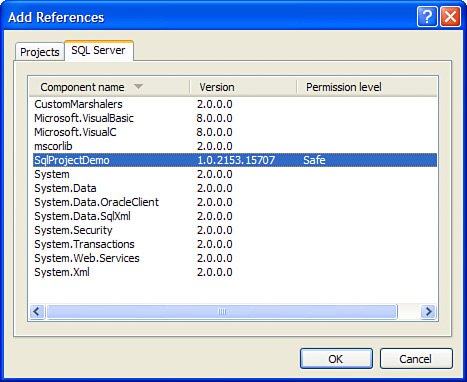| When writing stored procedures, types, functions, and more, you will need access to data and functionality provided by SQL Server. For example, when writing a C# stored procedure you need to be able to send results out on the "pipe." Also, you will want to be able to run your queries using the existing server-side connection and not have to resort to a client-side ADO.NET connection. All of this is available for you in a few classes, such as SqlContext and SqlPipe. Table 21.1 shows some of the methods and properties available on the Table 21.1. SqlPipe Properties and MethodsProperty/Method | Description |
|---|
IsSendingResults | Indicates whether the SqlPipe is currently sending results to the client. Read-only. | ExecuteAndSend() | Executes the specified command and sends the results on the pipe to the client. | Send() | Sends results to the client on the pipe. | SendResultsStart() | Indicates the beginning of results sent to the client, allowing you to send individual rows. When in this mode, the pipe will only accept calls from SendResultsRow and SendResultsEnd. | SendResultsRow() | Sends a row of data to the client. | SendResultsEnd() | Marks the end of a result set sent to the client. |
The code in Listing 21.4 illustrates how to use some of the methods of the SqlPipe class to send results to the client as well as how to create a command parameter that is one of your own UDTs. Listing 21.4. Using the SqlPipe Class and Creating a UDT Command Parameter using System; using System.Data; using System.Data.SqlClient; using System.Data.SqlTypes; using Microsoft.SqlServer.Server; public partial class StoredProcedures { [Microsoft.SqlServer.Server.SqlProcedure] public static void RadarScan(int objectID, int scanRadius) { using (SqlConnection conn = new SqlConnection("context connection=true")) { conn.Open(); SqlCommand cmd = conn.CreateCommand(); cmd.CommandText = "SELECT Location FROM GameObjects WHERE ObjectID = " + objectID.ToString(); Point3D sourceLocation = Point3D.Null; SqlDataReader rdr = cmd.ExecuteReader(); if (rdr.Read()) { sourceLocation = (Point3D)rdr["Location"]; } rdr.Close(); // now select all objects within radar range SqlCommand scanCmd = conn.CreateCommand(); scanCmd.CommandText = "SELECT ObjectID, Name, Location.ToString() as CurrentLocation, " + "Location.DistanceFromPoint(@pointRef) as DistanceToTarget FROM " + "GameObjects WHERE Location.DistanceFromPoint(@pointRef) < " + scanRadius.ToString() + " AND ObjectID != " + objectID.ToString(); scanCmd.Parameters.Add(new SqlParameter("@pointRef", SqlDbType.Udt)); scanCmd.Parameters[0].UdtTypeName = "Point3D"; scanCmd.Parameters[0].Value = sourceLocation; // execute the command and send results to the calling client SqlContext.Pipe.ExecuteAndSend(scanCmd); rdr.Close(); } // no need to explicitly shut down connection because of 'using' statement } };
|
When this stored procedure is executed in a query environment, it gives the following results (for Object ID of 2, radar range of 20): 3 Battlecruiser DotNettica 9,7,3 19.7989898732233
These results indicate that, according to the GameObjects table, there is a ship called the "Battlecruiser DotNettica" almost 20 units away, at location (9,7,3). Obviously this procedure could have been written in T-SQL, but if you needed to take into account other factors such as whether that vessel is cloaked, moving, and so on, the C# procedure might prove computationally faster than its T-SQL equivalent. When you are working with a SQL Server project, you can't just add references as you see fit. When you go to add a reference, you are limited to other projects, and to assemblies already stored in SQL Server, as shown in Figure 21.3. Figure 21.3. Adding a reference to a SQL Server project. 
Another common task when working with the server-side SQL library is the creation and use of temporary tables. Often developers will need to create a temporary table to store dynamically generated results, and those results are then sent to the client. This same functionality is available to you in C# by giving you the ability to create your own metadata and send records that match that metadata. The code in Listing 21.5 shows a C# stored procedure that utilizes the SqlPipe class to send its own arbitrary data as well as the accompanying metadata. Listing 21.5. Sending Arbitrary Tabular Results using System; using System.Data; using System.Data.SqlClient; using System.Data.SqlTypes; using Microsoft.SqlServer.Server; public partial class StoredProcedures { [Microsoft.SqlServer.Server.SqlProcedure] public static void ArbitraryData() { SqlDataRecord record = new SqlDataRecord( new SqlMetaData("City", SqlDbType.NVarChar, 100), new SqlMetaData("Temperature", SqlDbType.Int)); // this sends the meta-data information, not the record itself SqlContext.Pipe.SendResultsStart(record); record.SetString(0, "Denver, CO"); record.SetInt32(1, 65); SqlContext.Pipe.SendResultsRow(record); record.SetString(0, "Durango, CO"); record.SetInt32(1, 43); SqlContext.Pipe.SendResultsRow(record); SqlContext.Pipe.SendResultsEnd(); } };
|
|
